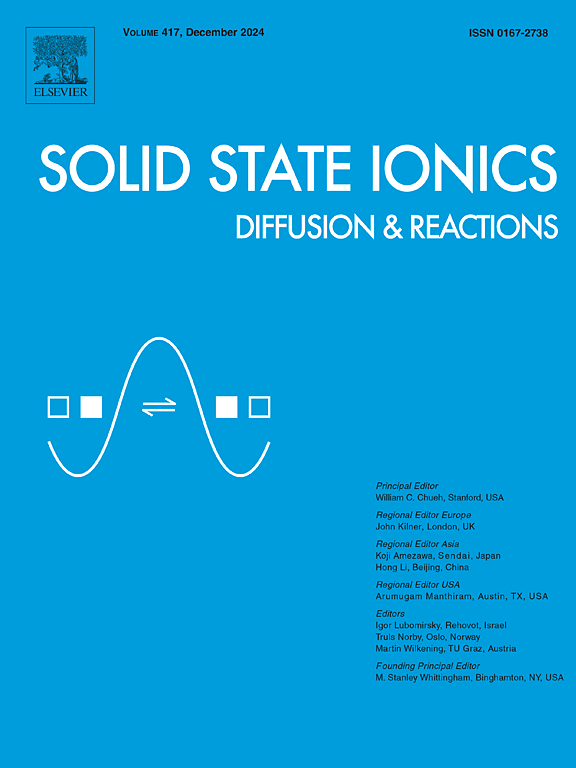The unique properties of the monomolecular surface layer of reduced ceria
IF 3
4区 材料科学
Q3 CHEMISTRY, PHYSICAL
引用次数: 0
Abstract
Experimental results of the defect concentrations in highly reduced, monomolecular surface layer of ceria-based oxides, are discussed. The data is XPS vs. oxygen pressure relations of reduced Pr0.1Ce0.9O2.-x (PCO), CeO2-x and Sm0.2Ce0.8O1.9-x (SDC). In PCO the analysis predicts that the surface layer is negatively charged and the concentration of Pr3+ ions is higher than in the bulk. A double layer exists between the surface layer and the bulk. In CeO2 and SDC the concentration of Ce3+ ions and oxygen vacancies in the surface is higher than in the bulk. The surface is neutral. The analysis predicts that the surface layer is metallic, i.e. the electrons on Ce3+ are delocalized and not localized small polarons. The bulk is a semiconductor. The Ce3+ ions are randomly distributed on the Ce sublattice and not in the boundary of oxygen vacancies. The latter are doubly ionized vacancies despite the presence of a high concentration of quasi free electrons. It is also predicted that the surface of ceria or SDC has a phase diagram of temperature vs. oxygen vacancy concentration, at T > 450 °C, like that of ceria bulk or SDC bulk, respectively. Further, the phase diagram of SDC bulk (and surface) is like that of ceria bulk shifted to a higher oxygen vacancy concentration and doping has no other effect at elevated temperature. Both in ceria and SDC the difference between the surface and the corresponding bulk is only in the oxygen pressure at which a level of reduction is reached, with the surface more easily being reduced than the bulk.
还原氧化铈单分子表面层的独特性质
讨论了高还原单分子氧化铈表面缺陷浓度的实验结果。数据为还原后的Pr0.1Ce0.9O2的XPS与氧压关系。-x (PCO), CeO2-x和Sm0.2Ce0.8O1.9-x (SDC)。在PCO中,分析预测表面层带负电荷,Pr3+离子浓度高于体内。在表层和本体之间存在双层。在CeO2和SDC中,表面的Ce3+离子浓度和氧空位均高于体中。表面是中性的。分析表明,Ce3+的表面层是金属的,即Ce3+上的电子是离域而非定域的小极化子。大块是半导体。Ce3+离子随机分布在Ce亚晶格上,而不是在氧空位的边界上。后者是双电离空位VO••,尽管存在高浓度的准自由电子。还预测了铈或SDC表面具有温度与氧空位浓度的相图,在T >;450°C,与二氧化铈块体或SDC块体的温度相同。此外,SDC体(和表面)的相图与氧化铈体在更高氧空位浓度下的相图相似,掺杂在高温下没有其他影响。在二氧化铈和SDC中,表面和相应体之间的差异仅在于达到还原水平的氧压,表面比体更容易被还原。
本文章由计算机程序翻译,如有差异,请以英文原文为准。
求助全文
约1分钟内获得全文
求助全文
来源期刊

Solid State Ionics
物理-物理:凝聚态物理
CiteScore
6.10
自引率
3.10%
发文量
152
审稿时长
58 days
期刊介绍:
This interdisciplinary journal is devoted to the physics, chemistry and materials science of diffusion, mass transport, and reactivity of solids. The major part of each issue is devoted to articles on:
(i) physics and chemistry of defects in solids;
(ii) reactions in and on solids, e.g. intercalation, corrosion, oxidation, sintering;
(iii) ion transport measurements, mechanisms and theory;
(iv) solid state electrochemistry;
(v) ionically-electronically mixed conducting solids.
Related technological applications are also included, provided their characteristics are interpreted in terms of the basic solid state properties.
Review papers and relevant symposium proceedings are welcome.
 求助内容:
求助内容: 应助结果提醒方式:
应助结果提醒方式:


